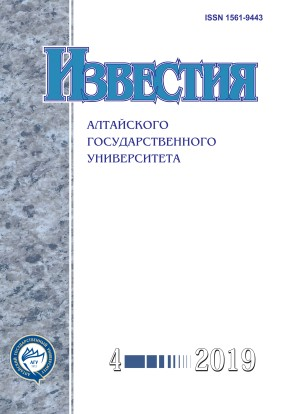The Structure of Secondary Conglomerates Formed due to Exposure of Gallstones to Laser Radiation
УДК 52-526
Abstract
The paper analyzes the features of structures and elemental compositions of gallstones depending on their types. Elemental compositions of gallstones were studied by x-ray fluorescence analysis, while their structures before and after exposure to laser radiation were studied by microscopy. The elemental compositions of all types of gallstones include the following trace elements: iron, chromium, nickel, copper, manganese, and sulfur. The combination of trace elements in the core and surface layers of gallstones depends on the type of gallstone. Section structures of gallstones of different elemental compositions before and after exposure to laser radiation and the structure of crystalline formations on their surface in relation to the time of exposure are studied in this paper. It is shown that the mechanism of destruction varies for different structural elements of gallstones. The fractal dimension of the objects formed on the surface of the sections after exposure to laser radiation is calculated. The analysis of the morphological pattern of structural changes in the surface of biomineral formations after exposure to laser radiation includes the determination of the following structural parameters: the integrity of the irradiation zone contours, the presence of structural damages and their nature.
Downloads
Metrics
References
Новикова Е.А., Малов А.Н., Вайчас А.А., Камышев И.А. О возможности лазерного управления процессами роста желчных камней // XII Всеросс. молодежный Самарский конкурс-конфер. научн. работ по оптике и лазерной физике : сборник конкурсных докладов. М., 2014.
Хрячков В.В., Левченко Н.В., Белоусов В.В. Прицельная контактная лазерная литотрипсия: новые возможности в лечении желчнокаменной болезни // Успехи современного естествознания. 2008. № 5.
Боровкова Е.В. Морфологические типы желчных камней // Вестник ин-та геологии. 2004. № 5.
Асланов А.М., Яловега Г.Э., Колмакова Т.С., Бржезинская М.М. Микроэлементный состав и ультраструктура желчных камней разного типа // Современные проблемы науки и образования. 2015. № 3.
Поляков В.В., Устинов Г.Г., Петрухно Е.В Исследование элементного состава и структуры желчных камней с помощью растровой электронной микроскопии // Медицинская физика. 2010. № 4 (48).
Поляков В.В., Устинов Г.Г., Петрухно Е.В. Применение многомерного анализа данных к исследованию физико-механических характеристик биоминеральных образований // Биомедицинская радиоэлектроника. 2011. № 12.
Устинов Г.Г., Поляков В.В. Структура и физико-механические свойства желчных камней : монография. Барнаул, 2014.
Суворова Е.И., Пантюшев В.В., Волошин А.Э. Методы анализа химического и фазового состава желчных камней // Кристаллография. 2017. Т. 62. № 6.
Размахнин Е.В., Коновалова О.Г. Особенности минерального состава желчных конкрементов при изучении спектров испускания свободных атомов и ионов в газовой фазе // Забайкальский мед. вестник. 2015. № 2.
Gondal M.A., Shemis M.A., Khalil A.A.I., Nasr M.M., Gondal B. Laser produced plasma diagnosis of carcinogenic heavy metals in gallstones. // JAAS: Journal of Analytical Atomic Spectrometry. 2016. V. 31. № 2.
Singh V.K., Rai A.K., Singh V, Thakur S.N., Rai P.K., Singh J.P. Quantitative analysis of gallstones using laser-induced breakdown spectroscopy. // Applied Optics. 2008. V. 47. № 31.
Машина Е.В., Пискунова Н.Н., Асхабов А.М., Макеев Б.А. Механизм роста кристаллов моногидрата холестерина в холелитах // Записки Российского минералогич. об-ва. 2015. Т. 144. № 5.
Франке В.Д., Гликин А.Э., Котельникова Е.Н., Плоткина Ю.В., Шугаев А.И., Козлов А.В., Салихов И.Н. Биоминералогия и кристаллогенезис желчных камней // Записки Российского минералогич. об-ва. 2008. Т. 137. № 5.
Агзамов Р.Ш., Трифонова Э.В. Дробление камней в желчном пузыре: непосредственные и отдаленные результаты // Сибирский мед. журнал. 2012. Т. 108. № 1.
Izvestiya of Altai State University is a golden publisher, as we allow self-archiving, but most importantly we are fully transparent about your rights.
Authors may present and discuss their findings ahead of publication: at biological or scientific conferences, on preprint servers, in public databases, and in blogs, wikis, tweets, and other informal communication channels.
Izvestiya of Altai State University allows authors to deposit manuscripts (currently under review or those for intended submission to Izvestiya of Altai State University) in non-commercial, pre-print servers such as ArXiv.
Authors who publish with this journal agree to the following terms:
- Authors retain copyright and grant the journal right of first publication with the work simultaneously licensed under a Creative Commons Attribution License (CC BY 4.0) that allows others to share the work with an acknowledgement of the work's authorship and initial publication in this journal.
- Authors are able to enter into separate, additional contractual arrangements for the non-exclusive distribution of the journal's published version of the work (e.g., post it to an institutional repository or publish it in a book), with an acknowledgement of its initial publication in this journal.
- Authors are permitted and encouraged to post their work online (e.g., in institutional repositories or on their website) prior to and during the submission process, as it can lead to productive exchanges, as well as earlier and greater citation of published work (See The Effect of Open Access).








